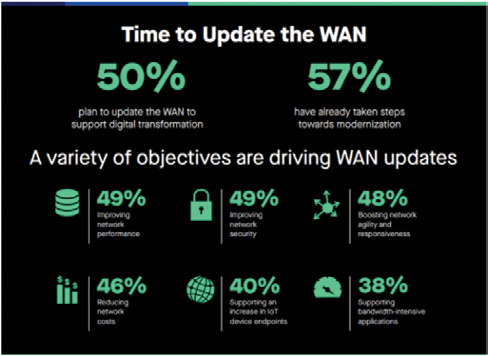THANK YOU FOR SUBSCRIBING
Editor's Pick (1 - 4 of 8)

Transforming Your Adaptive Network Solutions for the Digital Future
Matt Gutierrez, Senior Managing Director, CenturyLink Asia Pacific


Matt Gutierrez, Senior Managing Director, CenturyLink Asia Pacific
As more data is shared in more places, greater information security and network control is required to maintain performance.' And the digital world will not wait.
‘Organizations need granular insight and control over how, where, and with whom information is shared with. They need to accomplish this while maintaining on-demand response to business needs, requiring a flexible platform that quickly scales and implements change.’
Let us take a step back to uncover how adaptive networks have solved these issues.
As a business grows and customer demands increase, it will require a robust and high-performance network that will mirror this growth to provide reliable and secure data access. An adaptive network provides that support by incorporating intelligence and automation to handle transmission of data in a logical manner. For example, by utilizing real-time performance analytics to scale bandwidth requirements, assigning private network access to protect customer information, encrypting data to dynamically act upon cyber threats, or predicting customer behavior based on certain patterns.
Likewise, if a shared application that connects to the cloud experiences heavy traffic, you can assign direct Internet access for optimal performance and availability while assigning the required security policies. Best of all, these capabilities can be managed by IT teams via a single dashboard, to control numerous connected devices and gain visibility into how information is delivered over the Internet, private networks, or wireless connections.
 Challenged by WAN Modernization? IDG Research Survey, June 2018
To use an example, CenturyLink recently helped a global retailer quickly add network capacity to meet seasonal demand between data centers and cloud service providers so that the business could respond with agility and efficiency. This cloudification of the network is changing the landscape, which is driving new ways of delivering services. By deploying CenturyLink Dynamic Connections, the retail company received real-time, secure connectivity to augment seasonal capacity via a self-service portal, on a ‘Pay-As-You-Go’ model. This shows that the customer’s edge is not just at their physical premises anymore, and the cloud has become another location on their network.
What we see here is that fundamentally, an adaptive network is a conduit of IT agility and connected security, making up the three pillars of a successful digital business.
Data delivers exceptional customer experiences
Although networks are rapidly adapting to new market demands, it will be a continuous work in progress for IT teams to provision the next generation of technologies. This is particularly true for the gaming and entertainment industries. As they move to make digital content available to more people on more devices, the demand for ubiquitous mobile access to real-time data will increase.
Newzoo research predicts that mobile gaming will have grown from the smallest segment in 2012 to a US $100 billion industry in 2021. By that same year, the video streaming market in South East Asia is expected to have 107 million new subscribers, with the likes of Netflix, HOOQ and iflix competing for market and revenue share. Given that millennials and Gen Z are more likely to stream content than watch it on TV, it is also no longer enough for users to consume one mode of entertainment – several brands are discovering the power of multi-channel in keeping viewers engaged.
Both modern and traditional industries are also realizing the value in deploying new data strategies and networks that can adapt as their own businesses and customer experiences evolve. Some of the examples include banks and financial services increasing functionality and security on apps for an optimized digital banking experience.
‘These trends are only going to drive home further the value in establishing always-on, always available connectivity and network infrastructure in anticipation of increased customer demand.’
For these industries and more, end-user experience, service availability, and responsiveness are what helps set them apart in a saturated marketplace where emerging competitors are constantly entering the fray.
Establishing reliable, continuous connections
Users are spoilt for choice today, whether in every day routine experiences or when it comes to entertainment. Higher network quality and performance will undoubtedly be the starting points to cementing customer loyalty.
Asia Pacific now accounts for almost half of all worldwide video consumption. In fact, as of 2017, 95% of China’s 731 million Internet users consumed information on mobile devices. Video consumption and viewing habits are also changing around the world, leading to deeper market penetration by over-the-top (OTT) content providers such as Netflix, Amazon Prime, and Hulu. OTT providers – offering live event, live linear, and VOD offerings – are optimistic about future revenue projection and competitiveness. However, as they look to new revenue streams, these providers and emerging ones will increasingly rely on the power of adaptive networks to deliver the best content experiences to customers, regardless of how they choose to consume and connect.
But it is not just the video market that needs to prepare for the next generation. In 2017, Asia Pacific reached a revenue of US$71.4 billion, making the region the largest gaming market. Consumers want their favorite content in more places, on more devices and on their schedule. That’s why major broadcasting, media, and Internet companies turn to solutions such as CenturyLink Content Delivery Network to securely deliver video streaming, digital downloads, and website acceleration to their customers worldwide.
One such company is Mangomolo, when it launched its online video platform aiming to make it easier for publishers and broadcasters to deliver their content. Based in Lebanon, Mangomolo is experiencing the benefits of CenturyLink’s CDN solutions to deliver a seamless experience, even when faced with large amounts of traffic, and help the company break into new markets.
As usage of personal devices and unsecured Wi- Fi in business becomes commonplace, solutions such as CenturyLink Adaptive Network Security provide a secure network gateway to your company’s data while capturing and neutralizing security threats more efficiently and effectively.
Challenged by WAN Modernization? IDG Research Survey, June 2018
To use an example, CenturyLink recently helped a global retailer quickly add network capacity to meet seasonal demand between data centers and cloud service providers so that the business could respond with agility and efficiency. This cloudification of the network is changing the landscape, which is driving new ways of delivering services. By deploying CenturyLink Dynamic Connections, the retail company received real-time, secure connectivity to augment seasonal capacity via a self-service portal, on a ‘Pay-As-You-Go’ model. This shows that the customer’s edge is not just at their physical premises anymore, and the cloud has become another location on their network.
What we see here is that fundamentally, an adaptive network is a conduit of IT agility and connected security, making up the three pillars of a successful digital business.
Data delivers exceptional customer experiences
Although networks are rapidly adapting to new market demands, it will be a continuous work in progress for IT teams to provision the next generation of technologies. This is particularly true for the gaming and entertainment industries. As they move to make digital content available to more people on more devices, the demand for ubiquitous mobile access to real-time data will increase.
Newzoo research predicts that mobile gaming will have grown from the smallest segment in 2012 to a US $100 billion industry in 2021. By that same year, the video streaming market in South East Asia is expected to have 107 million new subscribers, with the likes of Netflix, HOOQ and iflix competing for market and revenue share. Given that millennials and Gen Z are more likely to stream content than watch it on TV, it is also no longer enough for users to consume one mode of entertainment – several brands are discovering the power of multi-channel in keeping viewers engaged.
Both modern and traditional industries are also realizing the value in deploying new data strategies and networks that can adapt as their own businesses and customer experiences evolve. Some of the examples include banks and financial services increasing functionality and security on apps for an optimized digital banking experience.
‘These trends are only going to drive home further the value in establishing always-on, always available connectivity and network infrastructure in anticipation of increased customer demand.’
For these industries and more, end-user experience, service availability, and responsiveness are what helps set them apart in a saturated marketplace where emerging competitors are constantly entering the fray.
Establishing reliable, continuous connections
Users are spoilt for choice today, whether in every day routine experiences or when it comes to entertainment. Higher network quality and performance will undoubtedly be the starting points to cementing customer loyalty.
Asia Pacific now accounts for almost half of all worldwide video consumption. In fact, as of 2017, 95% of China’s 731 million Internet users consumed information on mobile devices. Video consumption and viewing habits are also changing around the world, leading to deeper market penetration by over-the-top (OTT) content providers such as Netflix, Amazon Prime, and Hulu. OTT providers – offering live event, live linear, and VOD offerings – are optimistic about future revenue projection and competitiveness. However, as they look to new revenue streams, these providers and emerging ones will increasingly rely on the power of adaptive networks to deliver the best content experiences to customers, regardless of how they choose to consume and connect.
But it is not just the video market that needs to prepare for the next generation. In 2017, Asia Pacific reached a revenue of US$71.4 billion, making the region the largest gaming market. Consumers want their favorite content in more places, on more devices and on their schedule. That’s why major broadcasting, media, and Internet companies turn to solutions such as CenturyLink Content Delivery Network to securely deliver video streaming, digital downloads, and website acceleration to their customers worldwide.
One such company is Mangomolo, when it launched its online video platform aiming to make it easier for publishers and broadcasters to deliver their content. Based in Lebanon, Mangomolo is experiencing the benefits of CenturyLink’s CDN solutions to deliver a seamless experience, even when faced with large amounts of traffic, and help the company break into new markets.
As usage of personal devices and unsecured Wi- Fi in business becomes commonplace, solutions such as CenturyLink Adaptive Network Security provide a secure network gateway to your company’s data while capturing and neutralizing security threats more efficiently and effectively.
 Challenged by WAN Modernization? IDG Research Survey, June 2018
To use an example, CenturyLink recently helped a global retailer quickly add network capacity to meet seasonal demand between data centers and cloud service providers so that the business could respond with agility and efficiency. This cloudification of the network is changing the landscape, which is driving new ways of delivering services. By deploying CenturyLink Dynamic Connections, the retail company received real-time, secure connectivity to augment seasonal capacity via a self-service portal, on a ‘Pay-As-You-Go’ model. This shows that the customer’s edge is not just at their physical premises anymore, and the cloud has become another location on their network.
What we see here is that fundamentally, an adaptive network is a conduit of IT agility and connected security, making up the three pillars of a successful digital business.
Data delivers exceptional customer experiences
Although networks are rapidly adapting to new market demands, it will be a continuous work in progress for IT teams to provision the next generation of technologies. This is particularly true for the gaming and entertainment industries. As they move to make digital content available to more people on more devices, the demand for ubiquitous mobile access to real-time data will increase.
Newzoo research predicts that mobile gaming will have grown from the smallest segment in 2012 to a US $100 billion industry in 2021. By that same year, the video streaming market in South East Asia is expected to have 107 million new subscribers, with the likes of Netflix, HOOQ and iflix competing for market and revenue share. Given that millennials and Gen Z are more likely to stream content than watch it on TV, it is also no longer enough for users to consume one mode of entertainment – several brands are discovering the power of multi-channel in keeping viewers engaged.
Both modern and traditional industries are also realizing the value in deploying new data strategies and networks that can adapt as their own businesses and customer experiences evolve. Some of the examples include banks and financial services increasing functionality and security on apps for an optimized digital banking experience.
‘These trends are only going to drive home further the value in establishing always-on, always available connectivity and network infrastructure in anticipation of increased customer demand.’
For these industries and more, end-user experience, service availability, and responsiveness are what helps set them apart in a saturated marketplace where emerging competitors are constantly entering the fray.
Establishing reliable, continuous connections
Users are spoilt for choice today, whether in every day routine experiences or when it comes to entertainment. Higher network quality and performance will undoubtedly be the starting points to cementing customer loyalty.
Asia Pacific now accounts for almost half of all worldwide video consumption. In fact, as of 2017, 95% of China’s 731 million Internet users consumed information on mobile devices. Video consumption and viewing habits are also changing around the world, leading to deeper market penetration by over-the-top (OTT) content providers such as Netflix, Amazon Prime, and Hulu. OTT providers – offering live event, live linear, and VOD offerings – are optimistic about future revenue projection and competitiveness. However, as they look to new revenue streams, these providers and emerging ones will increasingly rely on the power of adaptive networks to deliver the best content experiences to customers, regardless of how they choose to consume and connect.
But it is not just the video market that needs to prepare for the next generation. In 2017, Asia Pacific reached a revenue of US$71.4 billion, making the region the largest gaming market. Consumers want their favorite content in more places, on more devices and on their schedule. That’s why major broadcasting, media, and Internet companies turn to solutions such as CenturyLink Content Delivery Network to securely deliver video streaming, digital downloads, and website acceleration to their customers worldwide.
One such company is Mangomolo, when it launched its online video platform aiming to make it easier for publishers and broadcasters to deliver their content. Based in Lebanon, Mangomolo is experiencing the benefits of CenturyLink’s CDN solutions to deliver a seamless experience, even when faced with large amounts of traffic, and help the company break into new markets.
As usage of personal devices and unsecured Wi- Fi in business becomes commonplace, solutions such as CenturyLink Adaptive Network Security provide a secure network gateway to your company’s data while capturing and neutralizing security threats more efficiently and effectively.
Challenged by WAN Modernization? IDG Research Survey, June 2018
To use an example, CenturyLink recently helped a global retailer quickly add network capacity to meet seasonal demand between data centers and cloud service providers so that the business could respond with agility and efficiency. This cloudification of the network is changing the landscape, which is driving new ways of delivering services. By deploying CenturyLink Dynamic Connections, the retail company received real-time, secure connectivity to augment seasonal capacity via a self-service portal, on a ‘Pay-As-You-Go’ model. This shows that the customer’s edge is not just at their physical premises anymore, and the cloud has become another location on their network.
What we see here is that fundamentally, an adaptive network is a conduit of IT agility and connected security, making up the three pillars of a successful digital business.
Data delivers exceptional customer experiences
Although networks are rapidly adapting to new market demands, it will be a continuous work in progress for IT teams to provision the next generation of technologies. This is particularly true for the gaming and entertainment industries. As they move to make digital content available to more people on more devices, the demand for ubiquitous mobile access to real-time data will increase.
Newzoo research predicts that mobile gaming will have grown from the smallest segment in 2012 to a US $100 billion industry in 2021. By that same year, the video streaming market in South East Asia is expected to have 107 million new subscribers, with the likes of Netflix, HOOQ and iflix competing for market and revenue share. Given that millennials and Gen Z are more likely to stream content than watch it on TV, it is also no longer enough for users to consume one mode of entertainment – several brands are discovering the power of multi-channel in keeping viewers engaged.
Both modern and traditional industries are also realizing the value in deploying new data strategies and networks that can adapt as their own businesses and customer experiences evolve. Some of the examples include banks and financial services increasing functionality and security on apps for an optimized digital banking experience.
‘These trends are only going to drive home further the value in establishing always-on, always available connectivity and network infrastructure in anticipation of increased customer demand.’
For these industries and more, end-user experience, service availability, and responsiveness are what helps set them apart in a saturated marketplace where emerging competitors are constantly entering the fray.
Establishing reliable, continuous connections
Users are spoilt for choice today, whether in every day routine experiences or when it comes to entertainment. Higher network quality and performance will undoubtedly be the starting points to cementing customer loyalty.
Asia Pacific now accounts for almost half of all worldwide video consumption. In fact, as of 2017, 95% of China’s 731 million Internet users consumed information on mobile devices. Video consumption and viewing habits are also changing around the world, leading to deeper market penetration by over-the-top (OTT) content providers such as Netflix, Amazon Prime, and Hulu. OTT providers – offering live event, live linear, and VOD offerings – are optimistic about future revenue projection and competitiveness. However, as they look to new revenue streams, these providers and emerging ones will increasingly rely on the power of adaptive networks to deliver the best content experiences to customers, regardless of how they choose to consume and connect.
But it is not just the video market that needs to prepare for the next generation. In 2017, Asia Pacific reached a revenue of US$71.4 billion, making the region the largest gaming market. Consumers want their favorite content in more places, on more devices and on their schedule. That’s why major broadcasting, media, and Internet companies turn to solutions such as CenturyLink Content Delivery Network to securely deliver video streaming, digital downloads, and website acceleration to their customers worldwide.
One such company is Mangomolo, when it launched its online video platform aiming to make it easier for publishers and broadcasters to deliver their content. Based in Lebanon, Mangomolo is experiencing the benefits of CenturyLink’s CDN solutions to deliver a seamless experience, even when faced with large amounts of traffic, and help the company break into new markets.
As usage of personal devices and unsecured Wi- Fi in business becomes commonplace, solutions such as CenturyLink Adaptive Network Security provide a secure network gateway to your company’s data while capturing and neutralizing security threats more efficiently and effectively.











